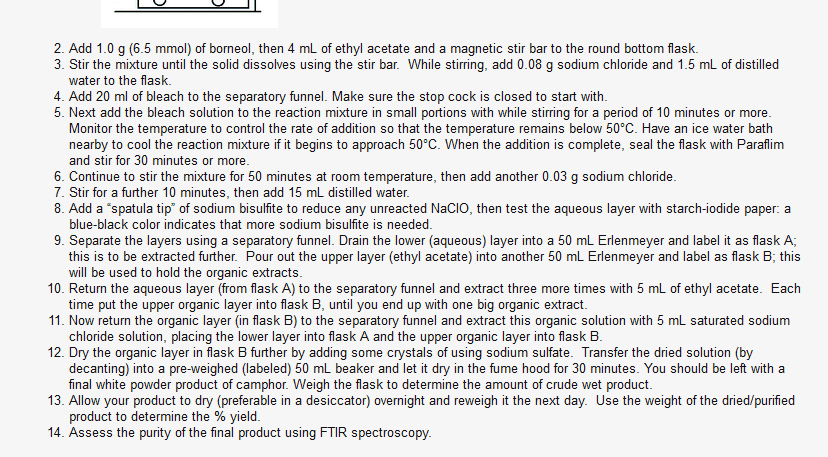Organic chemistry question about extraction lab...?
Procedure:
Place 2.0 g of the mixture of sucrose, acetylsalicylic acid and acetanilide into a 125 mL Erlenmeyer flask.
Add 50 mL of methylene chloride (dichloromethane) and dissolve as much of the solid as possible.
Remove the insoluble sucrose via gravity filtration using fluted filter paper. Allow to dry until the next lab period.
Add the methylene chloride solution to the separatory funnel and extract it with two 25 mL portions of 5 % sodium bicarbonate (aqueous).
Place the combined aqueous layers into a 400 mL beaker and add enough concentrated hydrochloric acid to make it very acidic (less than pH of 2) â approximately 10 mL
Allow the solid to crystallize from the aqueous layer. Chilling in an ice bath may be required.
When lots of solid has been formed, collect the solid by vacuum filtration. Wash the solid with approximately 5 mL of cold water
Allow the solid to dry open until the next lab period.
Dry the organic layer (methylene chloride) over anhydrous sodium sulfate.
Decant the solvent from the drying agent (or gravity filter through fluted filter paper) into a clean, dry a pre-weighed 100 mL round-bottom flask.
Evaporate the solvent using rotary evaporation and allow the residue to dry open over the week.
The following lab period, weigh all 3 solids, take the melting points of all 3 solids and calculate the percent composition of the original solid.
Drying agents:
Equations for drying agents:
MgSO4 (s) + 7 H2O(l) ï MgSO4.7H2O(s)
CaSO4(s) + 2 H2O(l) ï CaSO4.2H2O(s)
CaCl2(s) + 6 H2O(l) ï CaCl2.6H2O(s)
Na2SO4(s) + 7 H2O(l) ï Na2SO4.7H2O(s)
1. The original organic solution was extracted two times with aqueous sodium bicarbonate. After the extraction, what compound(s) were in the organic layer? What compound(s) were in the aqueous layer?
________________________________________________________________________________________________________________________________________________________________________________________________________________________
2. Assume that both acetylsalicylic acid and acetanilide are soluble in diethyl ether, and that diethyl ether was used in place of the methylene chloride. Would the ether layer be the bottom layer in the separatory funnel or the top layer? Explain your answer.
________________________________________________________________________________________________________________________________________________________________________________________________________________________
3. Assume that both acetylsalicylic acid and acetanilide are soluble in methanol, and that methanol was used in place of the methylene chloride. What problem(s) might occur during the extractions? (Careful, this is a trick question.)
________________________________________________________________________________________________________________________________________________________________________________________________________________________
4. Historically, the solid residue that is left after the methylene chloride solution is evaporated has a lower melting point that its literature value, due to impurities. Explain what impurities are present and why.
________________________________________________________________________________________________________________________________________________________________________________________________________________________
Organic chemistry question about extraction lab...?
Procedure:
Place 2.0 g of the mixture of sucrose, acetylsalicylic acid and acetanilide into a 125 mL Erlenmeyer flask.
Add 50 mL of methylene chloride (dichloromethane) and dissolve as much of the solid as possible.
Remove the insoluble sucrose via gravity filtration using fluted filter paper. Allow to dry until the next lab period.
Add the methylene chloride solution to the separatory funnel and extract it with two 25 mL portions of 5 % sodium bicarbonate (aqueous).
Place the combined aqueous layers into a 400 mL beaker and add enough concentrated hydrochloric acid to make it very acidic (less than pH of 2) â approximately 10 mL
Allow the solid to crystallize from the aqueous layer. Chilling in an ice bath may be required.
When lots of solid has been formed, collect the solid by vacuum filtration. Wash the solid with approximately 5 mL of cold water
Allow the solid to dry open until the next lab period.
Dry the organic layer (methylene chloride) over anhydrous sodium sulfate.
Decant the solvent from the drying agent (or gravity filter through fluted filter paper) into a clean, dry a pre-weighed 100 mL round-bottom flask.
Evaporate the solvent using rotary evaporation and allow the residue to dry open over the week.
The following lab period, weigh all 3 solids, take the melting points of all 3 solids and calculate the percent composition of the original solid.
Drying agents:
Equations for drying agents:
MgSO4 (s) + 7 H2O(l) ï MgSO4.7H2O(s)
CaSO4(s) + 2 H2O(l) ï CaSO4.2H2O(s)
CaCl2(s) + 6 H2O(l) ï CaCl2.6H2O(s)
Na2SO4(s) + 7 H2O(l) ï Na2SO4.7H2O(s)
1. The original organic solution was extracted two times with aqueous sodium bicarbonate. After the extraction, what compound(s) were in the organic layer? What compound(s) were in the aqueous layer?
________________________________________________________________________________________________________________________________________________________________________________________________________________________
2. Assume that both acetylsalicylic acid and acetanilide are soluble in diethyl ether, and that diethyl ether was used in place of the methylene chloride. Would the ether layer be the bottom layer in the separatory funnel or the top layer? Explain your answer.
________________________________________________________________________________________________________________________________________________________________________________________________________________________
3. Assume that both acetylsalicylic acid and acetanilide are soluble in methanol, and that methanol was used in place of the methylene chloride. What problem(s) might occur during the extractions? (Careful, this is a trick question.)
________________________________________________________________________________________________________________________________________________________________________________________________________________________
4. Historically, the solid residue that is left after the methylene chloride solution is evaporated has a lower melting point that its literature value, due to impurities. Explain what impurities are present and why.
________________________________________________________________________________________________________________________________________________________________________________________________________________________

